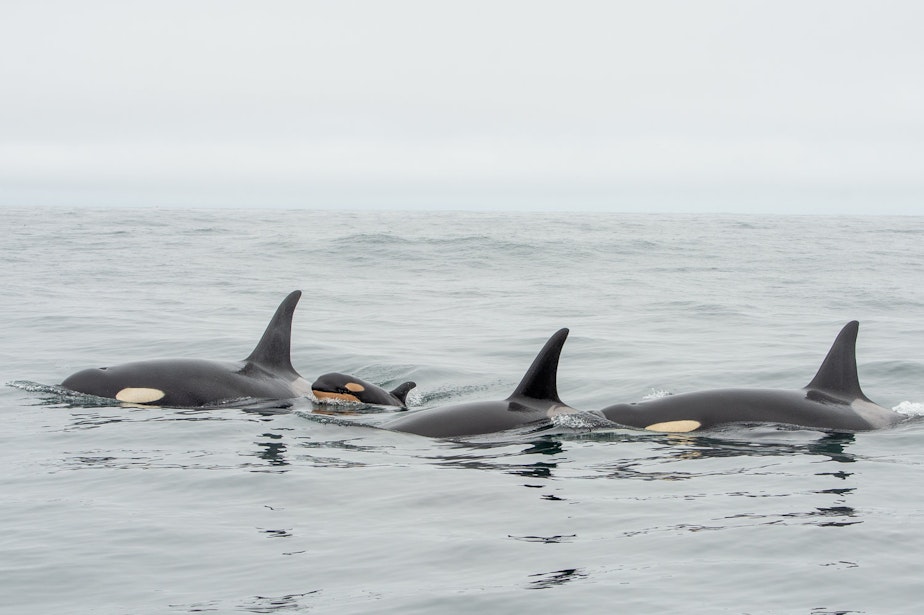What are that new baby orca’s chances of surviving?

Scientists and whale lovers celebrated when a baby orca was spotted off the west coast of Vancouver Island in May.
The calf, still ruddy and wrinkled from its time in the womb, brings the endangered population of southern resident killer whales up to 76.
That’s a slight bump up from last year’s 30-year low of 74 whales: a population so small that the death or survival of a single animal is important to its continued existence.
No calf born to the southern residents in 2016, 2017 or 2018 has survived.
One became a posthumous, worldwide celebrity of sorts last summer when its mother carried its lifeless body around on her nose for more than two weeks.
A calf born to the L pod in January 2019 appeared to be healthy when spotted in California’s Monterey Bay on March 31.
Listen to KUOW environment reporter John Ryan speak with host Angela King about the prospects for the newest member of J pod by clicking the play button above.
Scientists don’t know who the new calf’s parents are yet.
Inbreeding has been a big problem for this small population of whales, with just 2 males fathering more than half of all babies born in recent decades.
This calf was estimated by the Center for Whale Research to be less than 3 weeks old when it was spotted swimming with three female members of J pod near Tofino, British Columbia.
University of Washington biologist Deborah Giles said who the mother is could strongly influence the calf’s odds of survival in an ocean where salmon have become scarce and pollutants common.
Orca mothers offload long-lasting, toxic pollutants like PCBs in their flesh to their young when they nurse them.
• J40 is 15 years old and scientists have never seen her with a calf. If this calf is hers, and she has not given birth before, her milk would include not just nutrients but a potent dose of toxics that have accumulated in her flesh her whole life.
• J46 is 10 years old and is not known to have had a baby before. Her milk could have a decade’s accumulation of PCBs in it—less, presumably than J40’s 15-year load.
• J31, 24 years old, had her first calf in 2016, which died. J31 carried it around on her nose for a day. With a second calf, she could have a much smaller accumulation of toxics to pass on to her newborn.
Scientists are waiting for the newborn orca and its relatives to return to the inland waters of Washington and British Columbia, where it’s much easier to photograph or obtain DNA samples from them. Researchers do so by capturing droplets from the whales’ exhaled breath at the surface or the feces that floats up behind them.
Despite their “resident” moniker, the endangered orcas have only rarely appeared in the inland waters in recent years.
“They’re smart animals. They’re going to go where the food is,” Giles said.
Normally, Giles said, this would be a good time of year for a baby orca and family to find food around the San Juan Islands as chinook salmon swim through on their way back to Canada’s Fraser River. But not this year.
“The Fraser runs are pretty abysmal and projections for salmon throughout entire Pacific Northwest are pretty bad,” she said.
The southern residents are endangered by three main factors: a lack of salmon and excesses of noise and toxic pollution.
The Washington legislature this year passed several laws aimed at addressing those threats, including measures to discourage property owners from building on or otherwise damaging salmon habitat on their land.
But legislators only funded about 10% of the shovel-ready habitat projects to help salmon and the orcas that eat them, according to Monika Wieland Shields with the Orca Behavior Institute.
"We have chronically underfunded salmon recovery for ten years,” Jacques White of Long Live the Kings said at the latest meeting of the governor's killer whale task force.
Studies by the Swinomish and Sauk-Suiattle tribes have found that it would take 90 years to bring back a healthy population of chinook salmon in the Skagit River basin, the birthplace of most chinook in Puget Sound, at the current pace of habitat restoration there.
“It’s pretty cut and dry: The lack of food is what's driving the lack of pregnancies and the loss of calves,” Giles said.
Near the international border, orcas might at least encounter less ship noise this summer.
Key foraging areas for orcas at the mouth of the Strait of Juan de Fuca and off Canada’s Pender and Saturna islands, immediately northwest of the San Juans, will be off limits to boat traffic from June to November.
The Port of Vancouver is also expanding its voluntary go-slow zone for large ships. This summer, it will wrap around the north side of the San Juans, in Boundary Pass, as well as the west side, in Haro Strait.
This story has been updated.




